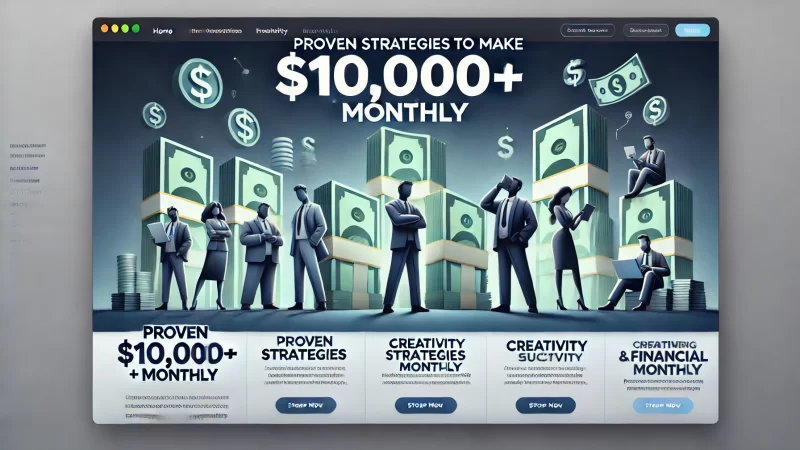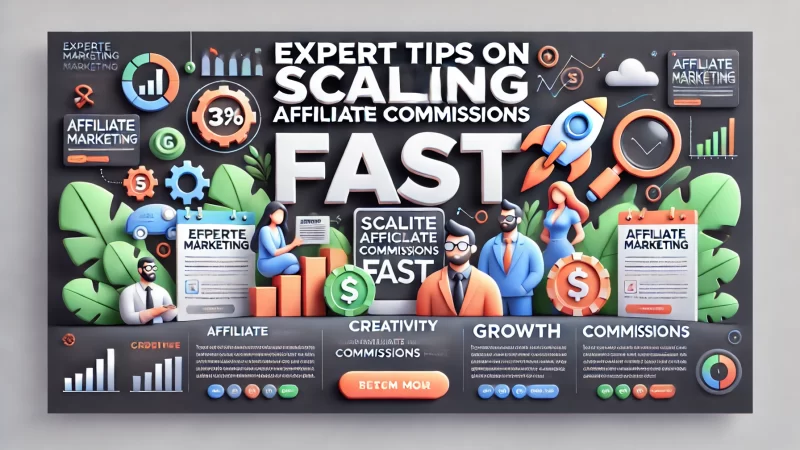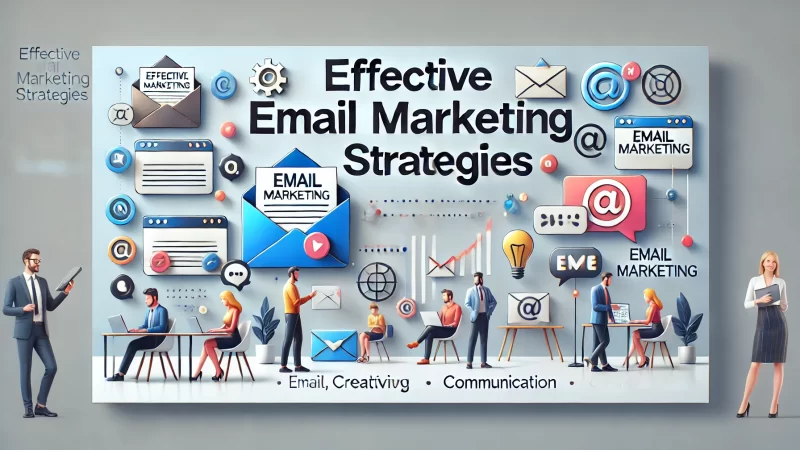Table of Contents
Make money with affiliate marketing—sounds promising, right? But how do you get to the point where you’re earning $10,000 or more every month? Are you wondering what advanced strategies, affiliate programs, or SEO tactics can take your business to the next level?
Whether you’re just starting or are an experienced affiliate, this guide will break down the proven steps to scaling your affiliate marketing efforts to hit that $10,000+ monthly milestone.
From choosing the best affiliate programs to leveraging SEO tools and building high-converting funnels, I’ll show you exactly how to structure your approach for maximum results. With the right focus, dedication, and the tips I’ll share, you’ll see how achievable this goal truly is.
Proven Strategies To Make $10,000+ Monthly With Affiliate Marketing

Making over $10,000 a month with affiliate marketing is entirely possible when you combine the right strategies with persistence. It’s all about selecting high-paying programs, driving consistent traffic, and optimizing your approach. I believe this goal becomes more achievable when you embrace a step-by-step system that scales as your expertise grows.
I suggest focusing on specific tactics like building content-rich websites, selecting high-converting affiliate programs, and using email marketing to capture and nurture leads. When you diversify your traffic sources and optimize your content for search engines, you significantly increase your chances of hitting your monthly earning goals.
How To Choose High-Quality Affiliate Programs That Convert Best
Selecting high-quality affiliate programs is critical if you want to reach significant income milestones. The programs you choose must align with your audience’s interests and offer competitive commissions. I’ve found that researching each program carefully, including their payout structure and reputation, is key to maximizing conversions.
I advise looking for programs that have reliable tracking systems and long cookie durations. These features help ensure that you get credit for sales even if a user doesn’t purchase immediately. Popular affiliate networks like FlexOffers and ShareASale are excellent places to start, offering a wide range of products and services to promote.
Don’t forget to focus on relevance. I suggest only promoting products that resonate with your audience’s pain points or needs. If your followers trust your recommendations, they’ll be more likely to click on your links and convert. Quality over quantity always wins in affiliate marketing.
Commission rates are another factor to consider. High-ticket items often result in more significant earnings, especially when paired with a high-converting funnel. Look for products or services that offer recurring commissions for long-term profits.
Building a relationship with affiliate managers can also help. I’ve noticed that when you cultivate these connections, you often gain access to exclusive deals, which can boost your earnings. It’s always worth asking for higher commissions if you prove yourself to be a top performer.
Key Metrics To Track When Selecting Affiliate Programs
Tracking the right metrics can make or break your affiliate marketing strategy. I believe the three most important metrics to keep an eye on are conversion rate, earnings per click (EPC), and average order value (AOV). These numbers will give you a clear picture of a program’s performance potential.
Earnings per click (EPC) is especially important. I always check this figure to see how much I could earn on average per click. Programs with high EPCs often indicate that the product or service is appealing and converts well. I suggest focusing on those that consistently show strong performance.
Conversion rate (CR) is another critical metric. A high conversion rate means that your audience is more likely to take the desired action, such as making a purchase. I recommend choosing programs with conversion rates above the industry average for optimal results.
Average order value (AOV) gives you insight into how much customers are spending. I’ve noticed that higher AOVs often lead to more substantial commissions, especially if the program has upsell opportunities. If you can promote products with large AOVs, your income will grow faster.
It’s also essential to track the refund rate. I suggest avoiding programs with high refund rates, as they can negatively impact your earnings. Stick with reputable programs that deliver on their promises and offer quality products.
Cookie duration is another vital aspect to consider. Longer cookie durations mean you have a better chance of earning commissions, even if the customer doesn’t purchase immediately. I suggest looking for programs that offer cookies lasting at least 30 days for the best results.
How to Leverage FlexOffers, MyLead, ShareASale, Awin & Fireads
FlexOffers, MyLead, ShareASale, Awin, and Fireads are powerful affiliate networks that offer unique opportunities for marketers. I find these platforms to be incredibly versatile, providing a wide range of products and services across multiple industries. Whether you’re targeting physical products or digital services, these platforms have something for everyone.
I love FlexOffers for its extensive range of high-ticket offers and excellent reporting tools. It’s ideal for affiliates who want to dig deep into analytics to fine-tune their campaigns. I’ve also found that its variety allows for greater flexibility in testing different niches and strategies.
MyLead is a fantastic platform for marketers who want to promote offers in global markets. I think its interface is user-friendly, and the platform covers niches from finance to gaming, making it ideal for affiliates who want to explore diverse opportunities. Plus, it offers some impressive payout rates on CPA offers.
ShareASale stands out for affiliates promoting physical products. I believe it’s one of the best networks for e-commerce affiliates, thanks to its robust selection of merchants. You can tap into major brands that your audience already trusts, making conversions more likely.
Awin is perfect for seasoned marketers looking for premium brand partnerships. I suggest using Awin to promote high-end products because it features top-tier companies that can elevate your affiliate earnings. It also has excellent tracking tools to help optimize your campaigns.
Fireads, on the other hand, is well-suited for digital marketers focusing on lead generation and CPA offers. I find that its emphasis on lead-driven campaigns makes it a great option for affiliates who specialize in generating traffic through paid ads or email marketing.
Expert Tips On Scaling Affiliate Commissions Fast

Scaling your affiliate commissions isn’t just about increasing traffic—it’s about optimizing every part of your funnel to maximize conversions. I’ve learned that focusing on consistent growth through content marketing, strategic traffic generation, and email marketing automation is crucial.
A significant part of scaling is testing different offers and refining your approach. As you grow, I advise investing time in understanding what resonates most with your audience. This allows you to scale more effectively while maximizing ROI.
The Role Of Content Marketing In Affiliate Success
Content marketing plays a crucial role in affiliate success. I always recommend producing high-quality, engaging content that solves a problem for your audience. Content helps build trust, which is essential for affiliate conversions. When you create value-driven blog posts, product reviews, and guides, you position yourself as an authority in your niche.
Another approach I love is evergreen content. When I focus on creating content that remains relevant over time, it generates passive traffic and income. Think of it like planting seeds; the more evergreen content you produce, the more your income grows.
Promotional content works best when it’s not overly salesy. I find that soft selling, where you weave product recommendations into helpful articles, drives more conversions. Readers appreciate content that educates them first before suggesting a product as a solution.
Regularly updating your content is something I emphasize. SEO trends and affiliate programs change, so keeping your content fresh ensures your traffic continues to grow. Plus, updating posts with new information boosts your rankings, leading to more clicks and conversions.
I also advise adding multimedia elements like videos or infographics. I’ve noticed that engaging visuals increase the time visitors spend on a page, making them more likely to convert. This is especially important for product reviews or tutorial content.
Advanced Traffic Generation Tactics To Boost Affiliate Sales
To scale your affiliate income, advanced traffic generation strategies are essential. I’ve found that diversifying your traffic sources—organic, paid, and social—leads to more consistent and scalable income. I recommend combining SEO, PPC, and social media marketing for maximum impact.
SEO is the backbone of sustainable traffic. I suggest using tools like Squirrly or AIOSEO to optimize your site for long-tail keywords that convert. Focus on high-intent keywords, as they often lead to faster conversions and better traffic quality.
Paid traffic, particularly through Google Ads or Facebook Ads, can quickly scale your efforts. I believe that testing small ad budgets and optimizing based on performance is the best approach. When done correctly, paid traffic can deliver rapid results and help you reach a broader audience.
Social media platforms are also an excellent source of traffic. I suggest leveraging Instagram, Pinterest, and YouTube, where affiliate links can be naturally embedded into engaging content. Platforms like these offer the potential for viral growth, driving significant traffic.
I also encourage using influencer marketing to amplify reach. Partnering with influencers in your niche helps you tap into a pre-existing audience that trusts the influencer’s recommendations, increasing your chance of conversions. This strategy can lead to a big traffic boost.
Finally, remarketing is essential. I recommend setting up remarketing campaigns to target users who have visited your site but didn’t convert. It’s a powerful way to recapture potential buyers and increase overall conversions.
Maximizing Your Earnings Through Email Marketing Automation
Email marketing is one of the most effective ways to maximize affiliate earnings. I suggest building an engaged list early on, as it allows you to nurture your audience and promote relevant offers directly. Over time, I’ve found that a well-segmented email list becomes one of your biggest assets.
Automation is key to scaling email marketing. Tools like Aweber or Omnisend allow you to set up automated email sequences that guide subscribers through a funnel, from welcome emails to product recommendations. I love how these tools make email marketing hands-off while increasing conversions.
Personalization in emails is something I emphasize. I’ve noticed that emails with personalized subject lines and content have significantly higher open rates and engagement. I recommend using tools like MailPoet to tailor email content based on user behavior.
Segmenting your email list based on interest, behavior, or purchase history allows for more targeted marketing. I suggest creating different email funnels for different segments, offering them products that align with their specific needs or pain points.
Lastly, tracking email performance is crucial. I use email marketing tools like GetResponse or Moosend to analyze open rates, click-through rates, and conversions. These insights help refine future campaigns for better results.
Niche Selection And Keyword Research For Lucrative Earnings

Choosing the right niche is essential for success in affiliate marketing. I believe that a profitable niche has a balance between passion, demand, and earning potential. When you focus on a niche that resonates with your interests, creating consistent and valuable content becomes easier, and this content naturally attracts a targeted audience.
Keyword research complements niche selection by helping you identify specific topics that people are searching for. I recommend using SEO tools like SEOPowersuite or Semrush to find high-volume, low-competition keywords. This method positions you for organic growth, as you’ll rank higher for relevant terms that drive qualified traffic.
Profitable Niche Markets You Can Tap Into Right Now
There are several niche markets with high potential for affiliate marketers. I find the health and wellness niche to be incredibly lucrative, especially with sub-niches like mental health and fitness supplements. These niches not only have high demand but also offer products that people regularly buy, creating recurring revenue.
The tech industry is another strong niche. I’ve heard that promoting tech gadgets, software, or even online courses can lead to impressive commissions. The key here is finding products with good commission structures and continuous innovation, which keeps the audience engaged.
I also suggest exploring the finance niche, focusing on credit repair, investment platforms, or budgeting tools. People are always searching for ways to manage their money better, and promoting tools that help them do that can result in steady commissions.
Sustainability and eco-friendly products are emerging niches with growing demand. I’ve noticed that audiences are increasingly looking for green alternatives, from reusable household items to sustainable fashion. As an affiliate, you can tap into this growing market and build authority in a space that prioritizes ethical consumption.
Finally, consider the pet industry. I think promoting pet care products, training courses, or pet insurance can be a goldmine. Pet owners are passionate about their furry friends and are often willing to spend on high-quality products, giving affiliates consistent sales opportunities.
Using SEO Tools Like AIOSEO, Semrush, and Sitechecker To Rank Higher
SEO tools are critical for optimizing your affiliate marketing efforts. I advise using AIOSEO to ensure your on-page SEO is flawless. It helps you optimize everything from meta tags to internal links, increasing your chances of ranking on Google and bringing in organic traffic consistently.
I believe Semrush is indispensable when it comes to keyword research. It allows you to analyze your competitors, uncover ranking opportunities, and find profitable keywords. I often use it to track my progress over time, which helps refine my SEO strategy for better results.
Sitechecker is excellent for identifying technical SEO issues that might be holding your site back. I suggest running regular audits with Sitechecker to fix broken links, improve load times, and enhance mobile responsiveness. This boosts your user experience and improves your chances of ranking higher.
Semrush also has a backlink analysis tool that I recommend using. Backlinks are crucial for building domain authority, and Semrush helps you discover opportunities for link building. By analyzing competitor backlinks, you can reach out to sites for guest posts or collaborations, increasing your site’s credibility.
Finally, I find that AIOSEO integrates well with most WordPress sites, making it a must-have for affiliate marketers. It simplifies SEO, allowing you to optimize your content without needing technical expertise. This tool helps you rank faster and more efficiently, even in competitive niches.
How To Build Content Hubs Around High-Value Keywords
Building content hubs is an advanced strategy that I recommend for affiliate marketers who want to dominate their niche. A content hub is a collection of articles and resources around a central theme, allowing you to target high-value keywords and become an authority in your niche.
Start by identifying the main topic or pillar content for your hub. I suggest picking a broad keyword related to your niche, such as “fitness for beginners” or “personal finance tips.” This main article will serve as the core of your hub, linking to more specific subtopics.
Each supporting article should target long-tail keywords that complement your main content. I’ve found that writing in-depth articles on these subtopics, such as “beginner workout plans” or “how to save for retirement,” attracts organic traffic. The internal linking also helps with SEO, improving your overall rankings.
Consistency is key when building content hubs. I recommend updating your articles regularly to reflect the latest trends and best practices. Search engines prioritize fresh content, and regularly updating your hub ensures you stay relevant, helping you retain your ranking over time.
You can also add multimedia elements like videos or infographics to your content hub. I’ve noticed that this makes your content more engaging, leading to longer visitor sessions and, ultimately, higher conversion rates. High-quality, visual content adds value and keeps users coming back for more.
Building High-Converting Affiliate Funnels That Drive Results

A well-structured affiliate funnel can be a game-changer for your earnings. I believe that creating a high-converting funnel involves guiding potential customers through each stage, from awareness to decision. Funnels make it easier to nurture leads, build trust, and increase conversions.
Each step in the funnel should serve a specific purpose. I recommend focusing on delivering value and addressing your audience’s pain points, which will make them more likely to trust your recommendations and convert into buyers.
Understanding The Funnel Stages: Awareness, Consideration, Decision
Understanding the different stages of a funnel is critical. The awareness stage is where potential customers first discover your content. I focus on creating informative, non-promotional content that draws visitors in, such as blog posts or social media content that answers common questions.
The consideration stage is where I suggest providing more detailed information to move prospects further down the funnel. Here, product reviews, comparisons, or case studies work well to showcase the benefits of what you’re promoting. Your goal is to help them evaluate their options.
During the decision stage, I emphasize clear calls to action (CTAs) that encourage prospects to take the final step and purchase. This is where I recommend using compelling language and limited-time offers to create urgency. The key is making the buying process as seamless as possible.
It’s also essential to personalize the funnel experience at each stage. I believe that segmenting your audience based on behavior or interest allows you to deliver more relevant content. This boosts engagement and conversion rates since you’re providing exactly what they’re looking for.
Lastly, track the performance of each stage. I’ve found that optimizing your funnel over time leads to higher conversions. Use tools like Google Analytics or Semrush to see where users drop off, and make improvements to keep them moving forward in the funnel.
Creating A Winning Landing Page That Converts Visitors Into Buyers
Landing pages are essential for converting visitors into buyers. I suggest focusing on clear, concise messaging that immediately communicates the value of your offer. Your landing page should include a compelling headline, engaging visuals, and a straightforward CTA that guides visitors to the next step.
A/B testing is a tactic I highly recommend. Test different headlines, images, or even button colors to see what resonates most with your audience. I’ve found that small tweaks can lead to big improvements in conversion rates, so it’s worth experimenting to optimize your landing page.
It’s crucial to reduce distractions on your landing page. I advise keeping it simple, without too many links or options that might divert attention. The goal is to focus the visitor’s attention on your main offer, making it as easy as possible for them to take action.
Incorporating social proof is another powerful tactic. I recommend adding testimonials, reviews, or case studies to show that others have benefited from the product you’re promoting. This helps build trust and increases the likelihood that visitors will convert.
Finally, I suggest optimizing your landing page for mobile users. With more people browsing on smartphones, having a mobile-friendly design ensures you don’t miss out on potential sales. A fast-loading, responsive landing page can significantly boost your conversions.
Integrating Email Marketing With Funnels To Increase Revenue
Email marketing can significantly enhance your affiliate funnel. I recommend using automated email sequences to nurture leads and keep your audience engaged. Tools like Aweber or Mailmunch are great for setting up autoresponders that guide subscribers through each stage of the funnel.
Personalizing your emails makes a big difference. I’ve found that addressing recipients by name and tailoring content to their interests increases open rates. Personalization creates a stronger connection, which is crucial for driving conversions from your email list.
I also suggest segmenting your email list. By dividing your audience based on their behavior, such as what they’ve clicked or purchased, you can send more relevant offers. This results in higher engagement and more sales because you’re meeting their specific needs.
Timely follow-ups are essential for boosting conversions. I’ve noticed that sending reminder emails or offering exclusive discounts to those who haven’t completed a purchase can recover lost sales. Email automation tools make it easy to set up these sequences.
Lastly, measure the performance of your email campaigns. I advise tracking key metrics like open rates, click-through rates, and conversion rates to see what’s working. By analyzing this data, you can refine your strategy and continuously improve your funnel’s performance.
Leveraging SEO Tools To Dominate The Affiliate Marketing Space

Using the right SEO tools is essential for staying ahead in affiliate marketing. I believe mastering these tools helps you optimize your content and outperform competitors. They allow you to rank higher, drive organic traffic, and improve visibility. With the right strategies, SEO can become your biggest source of leads and conversions.
I recommend investing time in learning how to leverage SEO tools like Rank Math and Squirrly. These platforms simplify the process of optimizing your site, making sure it ranks for relevant keywords. Whether you’re just starting out or already have experience, these tools can dramatically boost your affiliate earnings.
How To Use AIOSEO And Squirrly For Optimizing Affiliate Sites
Rank Math is a powerful tool I use to optimize affiliate sites. It offers features like on-page SEO analysis and schema markup, which help improve search engine rankings. I suggest using its keyword optimization feature to find the best terms to target for higher visibility. With Rank Math, you get an easy-to-use dashboard that simplifies the SEO process.
I also recommend Squirrly for its AI-driven optimization. This tool gives you real-time insights into your SEO efforts, making it easier to refine your content as you create it. Squirrly’s keyword research feature helps you discover untapped opportunities, ensuring you can target the right audience with precision.
Both Rank Math and Squirrly offer advanced features like link-building suggestions and performance tracking. I’ve found these tools especially useful for identifying where I can improve my content or boost rankings. They provide practical tips that are easy to implement, no matter your skill level.
One feature I love in Squirrly is its weekly SEO audit. It evaluates your site and sends a detailed report, helping you stay on top of your optimization game. I suggest paying close attention to these audits to continuously improve your site’s ranking potential.
Finally, Rank Math’s social media integration allows you to optimize your posts for platforms like Facebook and Twitter. This is invaluable for driving traffic from social channels while boosting your SEO efforts. I always make sure to customize meta tags and descriptions for each platform.
Getting More Insights With Serpstat And SEO Buddy
Serpstat is one of my go-to tools for comprehensive SEO insights. It provides in-depth keyword analysis, helping you identify high-traffic terms in your niche. I suggest using Serpstat’s competitor analysis feature to see what’s working for others and find gaps you can fill in your content strategy.
SEO Buddy is great for organizing your SEO workflow. I’ve found its step-by-step SEO checklist helpful for staying on track and ensuring nothing gets overlooked. I suggest using it as a daily guide to tackle essential SEO tasks like keyword research, link building, and content optimization.
With Serpstat’s rank tracking tool, I can monitor keyword performance over time. It helps me adjust my strategy based on real data, improving my chances of ranking higher for competitive terms. I always recommend using rank tracking to stay informed about your SEO progress.
SEO Buddy also offers link-building recommendations. I’ve seen firsthand how valuable backlinks can be for improving your domain authority. By following SEO Buddy’s suggestions, you can reach out to the right sites for guest posts or collaboration opportunities, which help you build high-quality links.
Another useful feature in Serpstat is its site audit tool. I run audits regularly to identify technical issues that might be affecting my SEO. Fixing these problems, like broken links or slow load times, can make a big difference in how well your site ranks. It’s a game-changer for long-term SEO success.
Using WP Rocket To Speed Up Your Site For Better Rankings
Page speed is crucial for both SEO and user experience. I suggest using WP Rocket to optimize your site’s loading times. This tool offers powerful caching features that reduce the amount of time it takes for your pages to load. Faster sites rank better, and I’ve seen noticeable improvements by using WP Rocket.
One of the features I love in WP Rocket is its lazy loading option. This ensures that images and videos load only when users scroll down the page, which helps reduce load times. I advise enabling this feature to make your site feel more responsive, especially on mobile devices.
WP Rocket also minifies CSS and JavaScript files, which can significantly improve your site’s performance. I’ve found that this not only helps with SEO but also improves the user experience. Visitors are more likely to stay on your site and engage with your content when it loads quickly.
Another benefit of WP Rocket is its integration with content delivery networks (CDNs). I suggest setting up a CDN to distribute your site’s files across multiple servers, further reducing load times. This ensures that your site performs well for visitors from around the world, which is essential for global affiliate marketing.
Finally, I recommend using WP Rocket’s database optimization feature. Over time, your site accumulates unnecessary data that slows it down. WP Rocket helps clean up your database, removing things like post revisions and spam comments. This makes your site leaner and faster, improving both SEO and user experience.
Boosting Conversions With Effective Email Marketing Strategies

Email marketing remains one of the most effective ways to boost affiliate sales. I find it invaluable for nurturing leads and driving conversions over time. By creating well-targeted email campaigns, you can keep your audience engaged and promote products that resonate with their needs, ultimately increasing your commissions.
Automating your email campaigns saves time and ensures consistent communication with your subscribers. I recommend using tools like Aweber and GetResponse for creating personalized, automated sequences that guide users through your funnel. These platforms allow you to track and optimize your campaigns for better results.
Best Practices For Affiliate Email Campaigns Using Aweber And GetResponse
Aweber and GetResponse are two of my favorite email marketing tools. Aweber is perfect for beginners, offering a simple interface and powerful automation features. I suggest using its pre-built templates to quickly set up email campaigns that engage your audience and drive sales.
GetResponse, on the other hand, offers more advanced features like landing page builders and webinar hosting. I find these features invaluable for creating a holistic marketing experience. You can integrate webinars or courses into your affiliate marketing strategy to educate your audience before pitching products.
I always recommend segmenting your email list. Both Aweber and GetResponse allow you to segment based on subscriber behavior, such as what links they click or products they purchase. This makes it easier to send targeted emails, which I’ve noticed leads to higher open rates and conversions.
Personalization is key to email marketing success. I advise using the personalization features in Aweber and GetResponse to address subscribers by name and tailor content to their preferences. Personalized emails feel more genuine and have a stronger impact, leading to better results.
Lastly, track your performance. Aweber and GetResponse both offer in-depth analytics that show open rates, click-through rates, and conversions. I suggest analyzing these metrics to refine your email strategy. Optimizing based on performance data helps you continuously improve your results.
How To Use Omnisend And MailPoet For Personalized Automation
Omnisend is a great tool for automating personalized email campaigns. I find its segmentation and automation features particularly useful for affiliate marketing. You can create behavior-based automations, such as abandoned cart emails or post-purchase follow-ups, which drive engagement and conversions.
MailPoet is another tool I recommend, especially for WordPress users. It integrates seamlessly with WordPress, making it easy to manage your email campaigns without leaving your dashboard. I use MailPoet to create automated newsletters that keep my subscribers engaged and informed about new affiliate offers.
With Omnisend, you can also leverage SMS marketing. I suggest combining email and SMS for a multi-channel approach, as this increases your chances of reaching your audience. SMS messages have higher open rates, so integrating both can lead to better overall campaign performance.
Omnisend’s product recommendation feature is another favorite of mine. It uses customer data to suggest products that your subscribers are likely to purchase. I recommend using this feature to promote your affiliate products more effectively, as personalized recommendations drive higher conversions.
MailPoet, on the other hand, offers easy-to-use drag-and-drop builders. I suggest using its intuitive editor to create visually appealing emails that match your brand’s style. A well-designed email catches attention and encourages clicks, ultimately driving more affiliate sales.
Improving Deliverability With WP Mail SMTP And Mailbird Pro
Email deliverability is crucial for the success of your campaigns. I advise using WP Mail SMTP to ensure that your emails don’t end up in the spam folder. This tool helps configure your WordPress site to send emails through an SMTP server, improving your email deliverability rates significantly.
Mailbird Pro is another great tool for managing your inbox and ensuring you respond to subscriber queries promptly. I suggest using it to organize your email communication, so you never miss an important message from potential leads. Staying responsive builds trust and increases the chances of conversion.
One of the key benefits of WP Mail SMTP is that it integrates with multiple email services, including Gmail and SendGrid. I recommend connecting it to a reliable email service provider to boost deliverability. This integration ensures that your emails are authenticated, reducing the chances of them being marked as spam.
Mailbird Pro’s unified inbox feature allows you to manage multiple email accounts in one place. I’ve found this feature especially helpful when running different campaigns across several email platforms. It streamlines the process and saves time, making it easier to stay on top of your communications.
Lastly, WP Mail SMTP’s error tracking feature is something I always pay attention to. It notifies you when an email fails to send, allowing you to troubleshoot issues immediately. I suggest reviewing these error logs regularly to ensure your emails reach your audience without any problems.
The Importance Of Tracking & Analytics For Affiliate Marketers

Tracking and analytics are vital for affiliate marketers aiming to optimize their campaigns. I believe that without proper tracking, you’re essentially flying blind, unable to measure what’s working and what’s not. It’s essential to set up systems that provide insights into user behavior, conversions, and traffic sources.
I suggest focusing on tools like Google Analytics and affiliate-specific tracking software. These tools allow you to analyze patterns and identify opportunities for improvement. By understanding the data behind your campaigns, you can make informed decisions that maximize your earning potential and ensure long-term success.
Setting Up Tracking For Affiliate Links Using UTM Parameters
One of the simplest ways to track affiliate link performance is by using UTM parameters. I find that adding UTM codes to your URLs allows you to monitor traffic sources and user behavior more effectively. This helps you understand which platforms or campaigns are driving the most conversions.
To set up UTM parameters, I recommend using Google’s Campaign URL Builder. It’s straightforward and allows you to customize links for different campaigns. Tracking through UTM tags enables you to see how each affiliate link performs, which can guide future strategies.
Once your UTM parameters are set, you can analyze the data in Google Analytics. I’ve found that reviewing metrics like sessions, bounce rates, and conversions from each UTM-tagged link provides invaluable insights. This allows you to adjust your campaigns for better performance.
Make sure to organize your UTM links by campaign. I always suggest keeping your links well-labeled, such as by platform or promotion, to make the data easier to interpret. When everything is clear, you can make better decisions based on accurate tracking.
Finally, use UTM tracking to split-test different strategies. I often create multiple UTM links for the same campaign but tweak elements like headlines or calls to action. This way, I can see what works best, optimizing future promotions for higher earnings.
Monitoring Affiliate Campaign Performance With Google Analytics
Google Analytics is a powerful tool for tracking the performance of your affiliate campaigns. I recommend setting up specific goals in Analytics, such as tracking when users click on your affiliate links or make a purchase. This helps you measure the effectiveness of your efforts.
I advise paying close attention to the behavior flow in Google Analytics. This feature shows how users navigate your site before clicking on an affiliate link. It helps you identify which pages are most engaging and which ones might need improvement for better results.
One metric I like to focus on is the conversion rate from organic traffic. Knowing how well your SEO efforts are working is crucial for affiliate marketing. I suggest using this data to refine your keyword targeting and content strategy, ensuring that you attract high-intent visitors.
You can also monitor referral traffic to understand which sources drive the most clicks to your affiliate links. I recommend checking these reports regularly. When you know where your best traffic is coming from, you can double down on what’s working and expand those efforts.
Lastly, use Google Analytics to track the performance of your marketing funnels. I always review the drop-off points within my funnel to see where users are losing interest. With this information, you can optimize those weak points and improve overall conversion rates.
How To Leverage Split Testing For Higher Conversions
Split testing, or A/B testing, is a technique I recommend for boosting affiliate conversions. By testing different versions of a webpage or email, you can determine what drives more clicks and sales. It’s one of the most effective ways to refine your strategy and improve results over time.
Start by testing small elements like headlines, CTAs, or images. I’ve noticed that sometimes, a simple headline tweak can lead to a significant jump in conversions. Run these tests using tools like Google Optimize or Optimizely to compare performance between variations.
Once you’ve gathered enough data, focus on the version that delivers better results. I always recommend letting tests run for at least a week or until you have a statistically significant amount of traffic. This ensures you’re making decisions based on reliable data.
I suggest running multiple split tests over time. You can test different pages, offers, or even traffic sources. Each test provides new insights, helping you fine-tune your approach. Keep what works and discard what doesn’t to continuously improve your conversion rates.
Don’t forget to analyze the impact of each change. I like to track the performance of each split test in Google Analytics, comparing metrics like click-through rates and time on page. This helps you see exactly how each variation is affecting user behavior, leading to smarter decisions.
Common Mistakes To Avoid In Affiliate Marketing To Ensure Success
Even experienced affiliate marketers make mistakes that hinder their success. I believe identifying these pitfalls early can save you time, money, and frustration. Whether you’re new to the field or looking to improve, avoiding common errors will set you up for long-term success.
Consistency in your efforts, a strong SEO strategy, and building a loyal audience are all crucial elements to get right. These mistakes are easy to fix, but ignoring them can prevent you from reaching your full potential in affiliate marketing.
Underestimating The Importance Of Content Consistency
One of the biggest mistakes I’ve seen is underestimating the power of consistent content. When you fail to post regularly, your audience may lose interest, and your SEO rankings can drop. I recommend creating a content schedule that keeps you on track with frequent, valuable updates.
Consistent content not only drives traffic but also builds trust. I’ve noticed that audiences respond more positively when they see a steady flow of information from a brand they follow. Regular updates remind your audience to keep coming back for more, increasing your affiliate opportunities.
I advise creating evergreen content, which stays relevant over time. This type of content consistently drives traffic without requiring frequent updates. When you have a mix of evergreen and trending topics, you maintain both short-term and long-term engagement.
When you skip content consistency, you miss out on SEO benefits. Search engines reward fresh content, so regular updates help you rank better. I’ve seen firsthand how a consistent content strategy leads to more organic traffic, which in turn drives more affiliate conversions.
Lastly, set aside time for content promotion. I always suggest sharing your new content across various platforms like social media and email newsletters. The more consistently you promote, the more traffic you’ll generate, helping to boost your affiliate income.
Overlooking SEO And Keyword Research In Affiliate Campaigns
SEO is fundamental for driving organic traffic, yet many affiliates overlook it. I believe skipping SEO and keyword research means missing out on valuable free traffic. I always recommend using tools like Semrush or AIOSEO to find keywords that align with your affiliate niche.
Neglecting SEO can lead to poor rankings, which directly impacts your earnings. Without optimizing for search engines, your site will struggle to attract relevant visitors. I suggest focusing on both on-page and off-page SEO techniques to boost visibility and drive conversions.
Keyword research helps you understand what your audience is searching for. I advise targeting long-tail keywords with lower competition but high relevance. This approach makes it easier to rank and attracts more qualified traffic that’s likely to convert into sales.
Another common mistake is ignoring local SEO, even in affiliate marketing. I’ve noticed that targeting location-specific keywords can sometimes lead to quicker rankings. Even if you operate globally, optimizing for certain geographic areas can give you an edge in competitive niches.
Finally, I recommend regularly updating your keyword strategy. SEO trends change, and what worked last year might not work today. Staying on top of new keywords and adjusting your content accordingly helps keep your campaigns fresh and effective.
Not Building An Engaged Email List Early On
Building an email list should be a top priority for affiliate marketers. I believe waiting too long to start capturing emails is a critical mistake. An engaged email list gives you a direct line to your audience, allowing you to nurture leads and drive repeat conversions.
Start by offering valuable incentives to encourage sign-ups. I suggest creating a free guide, checklist, or exclusive content in exchange for email addresses. This method not only grows your list but also ensures that you attract people who are genuinely interested in your niche.
Once you have a list, focus on providing consistent value. I’ve seen that offering helpful content builds trust and keeps your audience engaged. Mix in affiliate promotions carefully, ensuring you strike a balance between providing value and making offers.
Automation is key to scaling your email list efforts. I recommend using tools like Aweber or GetResponse to create drip campaigns that nurture subscribers over time. This keeps your audience engaged without requiring constant manual effort, freeing up time for other marketing tasks.
Lastly, segment your list for better targeting. I’ve found that grouping subscribers based on their interests or behaviors leads to higher open rates and better conversions. Tailoring your emails to specific segments helps you deliver the right content to the right people, increasing your affiliate sales.
Frequently Asked Questions (FAQ)
What is the most important metric to track in affiliate marketing?
I believe the most important metric to track is your conversion rate. It tells you how many people who click on your affiliate links actually make a purchase or complete the desired action. This metric shows the effectiveness of your content and traffic sources in driving revenue.
How can I use UTM parameters for better tracking in affiliate marketing?
UTM parameters help you track the performance of individual links. I suggest using them to differentiate traffic sources, campaigns, or promotions. By adding UTM tags to your URLs, you can monitor which links generate the most clicks and conversions, giving you a clearer view of your most successful strategies.
Why is split testing important for affiliate marketing?
Split testing allows you to compare different versions of a page, email, or ad to see which one performs better. I recommend running A/B tests to refine your calls to action, headlines, or content. The insights gained from split testing can lead to higher click-through rates and conversions, boosting your affiliate revenue.
How can I avoid common SEO mistakes in affiliate marketing?
I advise focusing on thorough keyword research and regular content updates. Many affiliates overlook the importance of targeting long-tail keywords or neglect their on-page SEO. Using tools like AIOSEO and Semrush can help you optimize your content for search engines and avoid the mistake of ignoring SEO altogether.
When should I start building an email list for affiliate marketing?
The earlier, the better. I suggest starting to build your email list as soon as possible, even if your website traffic is still small. An email list allows you to directly nurture leads and promote affiliate offers over time. Waiting too long to focus on list building can result in lost opportunities for consistent affiliate income.
What’s the best way to use content consistency to boost affiliate success?
Consistent content creation builds trust and improves SEO rankings. I recommend setting a content calendar to regularly post new articles, videos, or social media updates. By keeping your audience engaged with fresh, valuable content, you encourage repeat visits and improve the chances of converting them through your affiliate links.






